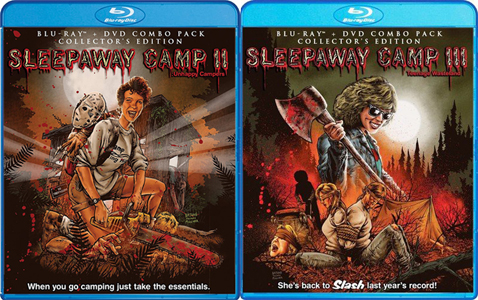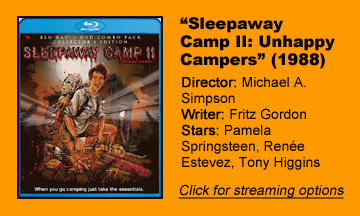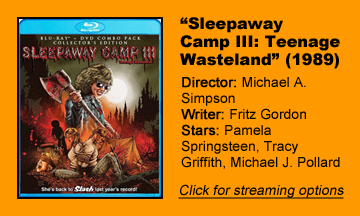“Sleepaway Camp” (1982) is a cult classic with mesmerizingly stiff direction, editing and acting that leads up to one of the most famous final-frame twists in horror history. The sequels aren’t as good, but the first two are mildly intriguing if you’re a fan of the original. Filmed back-to-back at the end of the slasher decade, both movies are directed by Michael A. Sampson and written by Fritz Gordon.
Two more sequels followed in this century, but they are difficult to track down and apparently horrible. So here’s a look at the completion of the 1980s “Sleepaway Camp” trilogy, as it were:
“Sleepaway Camp II: Unhappy Campers” (1988)
“Sleepaway Camp II: Unhappy Campers” is a more polished production than the original, which actually hurts it slightly. But Sampson gets in the ballpark and obeys the broad spirit of the original.
Gordon’s screenplay continues the concept of Angela (Pamela Springsteen, Bruce’s sister, who loosely resembles Felissa Rose) brazenly killing campers. In the original, she is the only suspect, but here we flat-out see her committing most of the murders. Angela is now a counselor, and again the casting is such that it’s hard to tell the young-adult counselors from the teen campers.
Starting with boys spying through a window on a cabin of topless girls heading for the showers, “SC2” is a type of movie they don’t make anymore.
It proceeds to offer consistent titillation (I suspect Valerie Hartman’s Ally lasts as long as she does because she’s easy to look at), creative kills (the outhouse scene is a standout) and touches of humor (both in tone and dialog), making for an 80-minute cheese-covered snack.
Though not as thematically rich as the original, “SC2” smartly continues Angela’s arc and traits. Eight years later, “Scream” outlined the horror-movie rule that promiscuous girls are always offed by the killer; Jamie Kennedy’s Randy could’ve pointed to this movie as an example of the weird marriage between strict morality and slasher murders.
The formerly mute Angela, now a chatterbox, quotes her aunt’s mantra about how if you follow a moral path, you can’t go wrong. Her victims are those who fornicate, flaunt their sexuality, do drugs or participate in panty raids. Angela holds herself to old-fashioned values like completing every task she sets out to do.
Gordon fails to add another layer of weirdness, which keeps “SC2” from matching the original. We’re told that Angela had a sex-change operation in her intervening years while institutionalized.
It might’ve been interesting if her anti-sex views were paired with sensitivity over her male body parts; this idea is teased when she turns down a fellow counselor’s suggestion that she work on her tan by the pool.
Another rejected approach would be a closing twist that makes us think about the film in a new way, like the 1982 entry does. I was suspicious that “SC2” might deliver an ending like that – for example, maybe Angela isn’t really Angela — and when it doesn’t, I was disappointed.

Instead, this never-scary movie goes for “one last scare,” a rare moment when “Sleepaway Camp II” doesn’t understand its own identity. It’s an unfortunate final impression.
“Sleepaway Camp III: Teenage Wasteland” (1989)
Out of the gates, “Sleepaway Camp III: Teenage Wasteland” has some fumes to coast by on, plus it introduces another respectable batch of good-looking “teens” (in reality, 20-somethings) in a story that takes place one year later at the re-opened camp. Angela wears a wig and poses as a camper named Maria.
A handful of creative but poorly executed (no pun intended) kills keep “SC3” eking along, but ultimately the “Sleepaway” series grows tired (pun intended this time). It devolves into a series of killings by Angela, whose motives are now out in the open and played for simplistic dark humor. She says “Strike three” after learning that one of her targets is a cheerleader, has had sex and uses drugs.
Springsteen barely seems to be trying anymore as the series leans into the comedy. While fishing for their dinner, Angela pulls a hockey mask out of the lake and her fellow campers mention that it’s Saturday the 14th. (“Friday the 13th Part VIII” came out the previous month, and it starts with Jason at the bottom of a lake.)
Gordon is obviously very aware of the genre he’s writing in, but “SC3” isn’t exactly a significant “Scream” influence.
“SC3” flies its Eighties flag with rich kids in stone-washed jeans, an inner-city black teen who listens to rap tapes and says “F*** that shit!” to every request that’s made of him. The n-word, s-word and f-word slurs pop up, but the tone is so lighthearted that it’s all rather harmless.
(No character actually is gay, but it’s an accusation that’s casually thrown around in both boys’ and girls’ cabins in 1980s movies.)
Meanwhile, Angela is a (supposedly post-op) transgender girl, but that’s not even referenced anymore. The closest we get is when she declines to remove her bra around the other girls.
Aside from the language, the movie is uninterested in exploring bigotry or the awkwardness of being an outsider. Angela now kills with ease, never worrying about getting caught or being foiled in a murder attempt (even though nearly every other camper should be able to overpower her or at least run away and hide).
Like part two, “Sleepaway Camp III” is precisely 80 minutes long, so it’s not painful to watch. But it’s ultimately a bad movie whereas the original is deserving of its cult classic status and the first sequel stays in the realm of fun.
“Sleepaway Camp II: Unhappy Campers”: 3.5 stars
“Sleepaway Camp III: Teenage Wasteland”: 2.5 stars



